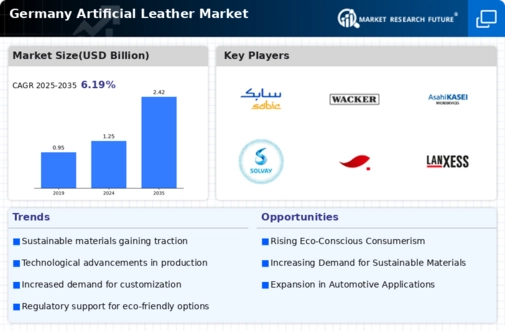The artificial leather market in Germany is characterized by a dynamic competitive landscape, driven by innovation, sustainability, and strategic partnerships. Key players such as BASF SE (DE), Bayer AG (DE), and Covestro AG (DE) are at the forefront, each adopting distinct strategies to enhance their market positioning. BASF SE (DE) focuses on developing bio-based alternatives to traditional synthetic materials, which aligns with the growing consumer demand for sustainable products. Bayer AG (DE) emphasizes innovation in its product offerings, particularly in the automotive and fashion sectors, where the demand for high-quality artificial leather is surging. Covestro AG (DE) is actively pursuing digital transformation initiatives, aiming to optimize its production processes and improve supply chain efficiency, thereby enhancing its competitive edge.
The market structure appears moderately fragmented, with several players vying for market share. Key business tactics include localizing manufacturing to reduce costs and improve responsiveness to market demands. Supply chain optimization is also a critical focus, as companies seek to mitigate risks and enhance operational efficiency. The collective influence of these major players shapes a competitive environment where innovation and sustainability are paramount.
In November 2025, BASF SE (DE) announced a partnership with a leading fashion brand to develop a new line of sustainable artificial leather products. This collaboration is significant as it not only reinforces BASF's commitment to sustainability but also positions the company as a leader in eco-friendly materials within the fashion industry. The partnership is expected to enhance brand visibility and attract environmentally conscious consumers.
In October 2025, Bayer AG (DE) launched a new range of high-performance artificial leather specifically designed for automotive applications. This strategic move is crucial as it addresses the increasing demand for lightweight and durable materials in the automotive sector, potentially capturing a larger market share. The innovation is likely to strengthen Bayer's position as a key supplier in the automotive industry, where performance and sustainability are critical.
In September 2025, Covestro AG (DE) unveiled a state-of-the-art digital platform aimed at streamlining its supply chain operations. This initiative is indicative of the company's commitment to digitalization, which is becoming increasingly vital in enhancing operational efficiency and responsiveness to market changes. By leveraging advanced technologies, Covestro is likely to improve its competitive positioning and reduce lead times in product delivery.
As of December 2025, current trends in the artificial leather market are heavily influenced by digitalization, sustainability, and the integration of AI technologies. Strategic alliances are increasingly shaping the competitive landscape, enabling companies to pool resources and expertise. The shift from price-based competition to a focus on innovation, technology, and supply chain reliability is evident. Moving forward, competitive differentiation will likely hinge on the ability to innovate and respond to evolving consumer preferences, particularly in sustainability and performance.






















Leave a Comment